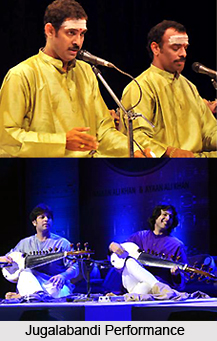 The tradition of Jugalbandi in the Carnatic and Hindustani styles of music is an age old one, where two skilled musicians, perform together. The literal meaning of Jugalbandi is "entwined twins". This duet performance could be instrumental or vocal.
The tradition of Jugalbandi in the Carnatic and Hindustani styles of music is an age old one, where two skilled musicians, perform together. The literal meaning of Jugalbandi is "entwined twins". This duet performance could be instrumental or vocal.
Partnership in vocal or instrumental music has been in trend since the day of Dhrupad. Khayal is mainly sung as a solo, but there have also been various cases of male duo singers, who usually belong to the same family. Even when two soloists perform together, they divide the improvisation between them so that there is still only one vocal part. This kind of performance demands cooperation not competition hence it takes considerable skill and intimacy to create a performance to which each of them will have to contribute equally. What defines Jugalbandi is that both the solo artists be on an equal footing. While any Indian music performance may feature two musicians, whether vocalists or instrumentalists, a performance can only be accounted a Jugalbandi if neither is clearly the soloist and neither clearly an accompanist. In Jugalbandi, both performers act as lead players, and a playful competition often proceeds between the two musicians.
In Hindustani music, Jugalbandi has only a marginal role. In contrast, Carnatic music can support the duet format on a larger scale, allow a larger orchestra, and also permit a freer interaction amongst the members of the ensemble. The difference arises from the role of the pre-composed element in the music. Despite the obstructions, a number of extraordinary duet performers have made Jugalbandi much popular.
Jugalabandi Patterns
In Jugalabandi patterns, sixteen significant partnerships, representing different degrees of acknowledged success are popular. This sample is based on the implication and stature of the musicians involved. The list has some overlaps, with musicians like Ustad Ali Akbar Khan and Ustad Vilayat Khan having partnered several instrumentalists over the years. The sixteen partnerships have been categorized into four categories:
•Traditional vocal, i.e., dhrupad and khayala;
•Traditional instrumental, combining instruments of the same basic organological classification (sitar/saroda and sitara/surabahara);
•Modern instrumental, combining organologically dissimilar instruments, e.g., sitara/sehnayi or santura/ flute;
•Experimental, which fall in none of the above categories and are still at an experimental stage of evolution.
Traditional Vocal
The largest and the most successful category is the traditional vocal, with six duos. Without exception, these pairs are brothers not far removed from each other in age, and trained simultaneously by the same guru. In most cases, the father is their guru or teacher.
Traditional Instrumental
The traditional instrumental category reports four winning partnerships. They have ties of shared tutelage, but not necessarily of kinship. In this category, one exception is significant - the brief but memorable collaboration of Ustad Vilayat Khan and Ustad Ali Akbar Khan in the 1950s.
Modern Instrumental
The modern instrumental category has three partnerships. Amongst these, Ustad Bismillah Khan-Ustad Vilayat Khan and Pt. Shiv Kumar Sharma-Hariprasad Chaurasia have been sensational successes. None of these pairs share a bond of common gurus or even Gharana affiliations.
Experimental
The fourth category, with four experimental partnerships, is a mixed bag. This category includes duets of the flautist, Pandit Hariprasad Chaurasia with Hindustani as well as Carnatic vocalists, and Dr. Balamurali Krishna Carnatic/Hindustani dialogues.




